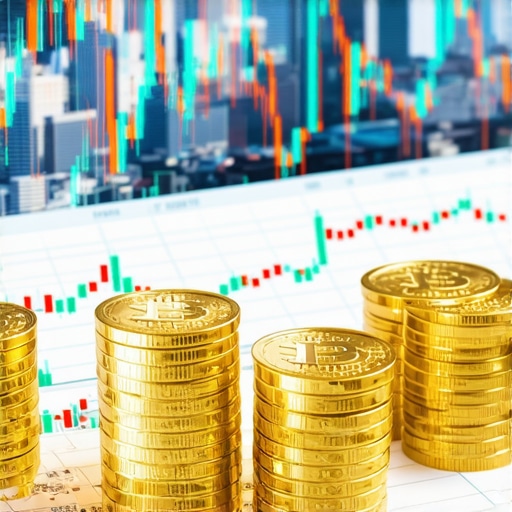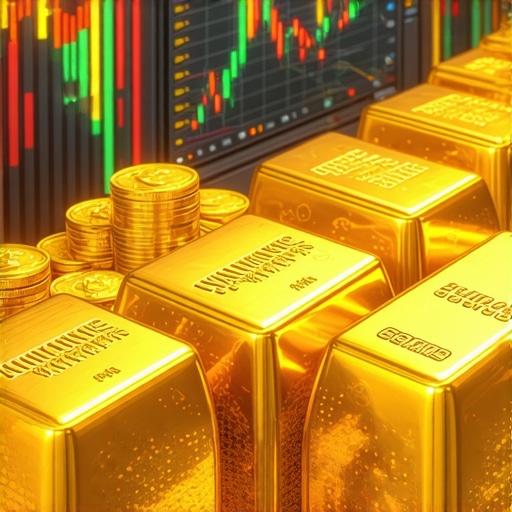Introduction to Gold Prices and Economic Changes
The relationship between gold prices and economic fluctuations is profound and intricate, making gold a unique asset for investors. Gold has historically been viewed as a safe haven during economic uncertainty. Understanding how gold prices react to economic changes can help investors make informed decisions and optimize their investment strategies.
The Role of Economic Indicators in Gold Pricing
Economic indicators such as inflation rates, interest rates, and unemployment levels play a crucial role in determining gold prices. For instance, when inflation rises, the purchasing power of currency declines, leading investors to flock to gold as a hedge against inflation. This increase in demand can drive gold prices higher. Similarly, low-interest rates make gold more attractive compared to interest-bearing assets, further boosting its appeal.
Inflation and Gold Prices
Inflation erodes currency value, prompting investors to seek assets that maintain value. Gold is often seen as a hedge against inflation. Historical data shows that during periods of high inflation, gold prices tend to rise significantly. For example, during the 1970s, when inflation soared, gold prices skyrocketed, illustrating this protective quality. Investors should closely monitor inflation trends and adjust their gold investment strategies accordingly.
Interest Rates Impact on Gold
Central banks influence interest rates, which in turn affect gold prices. When interest rates are low, the opportunity cost of holding gold decreases, making it more appealing to investors. Conversely, rising interest rates can lead to lower gold prices as investors move to interest-bearing assets. Understanding the correlation between interest rates and gold pricing is essential for strategic investment planning.
The Influence of Global Events on Gold Prices
Global events, such as geopolitical tensions, financial crises, and pandemics, also significantly affect gold prices. During times of crisis, investors often turn to gold as a safe-haven asset, driving up its price. For instance, the COVID-19 pandemic saw a surge in gold prices as uncertainty in the markets increased. Keeping an eye on global events can provide insights into potential shifts in gold prices.
Geopolitical Tensions and Gold
Geopolitical tensions can create market instability, prompting a rush to gold as a secure investment. Events such as wars or trade disputes often correlate with spikes in gold prices. Investors should stay informed about global political climates to anticipate potential impacts on gold prices.
Market Sentiment and Gold Demand
The psychology of investors plays a crucial role in gold demand. Market sentiment can drive prices in the short term, even if fundamental factors do not support such movements. Monitoring investor sentiment through reports and analyses can provide valuable insights into short-term price changes.
In conclusion, understanding how gold prices react to economic changes is vital for both novice and seasoned investors. By considering factors like inflation, interest rates, and global events, investors can navigate the complexities of the gold market more effectively. For more insights on investing in gold, you can explore our articles on best gold investment strategies or the impact of global events on gold prices.
Understanding Market Fluctuations and Gold Prices
The connection between market fluctuations and gold prices is critical for investors aiming to maximize their returns. Gold not only serves as a hedge against market downturns but also reacts to various economic indicators and investor behavior. This section delves into how market fluctuations can influence gold prices and what investors should consider when navigating this complex landscape.
Market Volatility and Gold Investment
Market volatility often leads to increased gold prices, as uncertainty drives investors towards safer assets. Economic downturns, stock market crashes, and currency devaluations can lead to a flight to gold. For instance, during the 2008 financial crisis, gold prices surged as investors sought stability. Understanding market conditions and their implications for gold can aid in making informed investment choices.
Investor Behavior During Economic Instability
Investor psychology plays a significant role in gold pricing. During economic instability, fear and uncertainty prompt many to liquidate riskier assets and invest in gold. Monitoring investor sentiment through economic reports and market analyses can provide insights into potential shifts in demand for gold. A shift towards gold during turbulent times can result in significant price increases, making it crucial for investors to stay informed.
Gold as a Diversification Tool
Incorporating gold into a diversified investment portfolio can mitigate risks associated with market volatility. Gold often moves inversely to equities, meaning that when stock prices fall, gold prices may rise. This inverse correlation makes gold an essential component for investors looking to balance their portfolios and safeguard against economic downturns. For more on diversification strategies, explore our article on gold versus stocks.
The Long-Term Trends in Gold Prices
While short-term fluctuations can be influenced by immediate economic events, long-term trends provide a broader perspective on gold pricing. Understanding these trends helps investors make strategic decisions over time. Historical data shows that gold has maintained its value over the long term, often appreciating during periods of economic uncertainty.
Historical Performance of Gold
Analyzing historical performance can provide valuable insights into gold’s resilience as an investment. Over decades, gold has demonstrated an ability to preserve wealth, especially during inflationary periods. Investors should review long-term gold price trends alongside economic indicators to anticipate future movements. For a deeper understanding, check our insights on gold price forecasts.
Global Economic Factors Influencing Gold
Economic conditions globally, such as currency fluctuations and international trade dynamics, can significantly impact gold prices. A weakening dollar usually leads to higher gold prices, as gold becomes cheaper for foreign investors. Additionally, central bank policies, particularly those involving gold reserves, can create ripple effects across global markets. Staying attuned to these factors can enhance investment strategies.
In summary, understanding how market fluctuations and investor behavior affect gold prices is essential for informed investing. By recognizing the significance of market volatility, historical trends, and global economic factors, investors can navigate the complexities of the gold market more effectively. For further insights into gold investment strategies, consider exploring our articles on spotting effective gold investments and essential investment techniques.
Understanding Gold Demand Dynamics
The dynamics of gold demand are influenced by various factors, including jewelry consumption, industrial applications, and investment trends. Each segment plays a crucial role in determining the overall demand for gold. Investors should recognize these dynamics to make informed decisions about their gold investments.
Jewelry Demand and Cultural Significance
Jewelry represents a significant portion of gold demand, especially in countries like India and China where cultural traditions emphasize gold as a symbol of wealth and status. Festive seasons and weddings often lead to spikes in gold purchases, impacting global prices. Understanding these cultural influences can help investors anticipate demand fluctuations. For more insights on this topic, check our article on gold demand trends.
Industrial Uses of Gold
Gold’s unique properties also lend it to various industrial applications, including electronics and dentistry. As technology advances, the demand for gold in high-tech products is expected to grow. Investors should stay informed about technological trends that may influence gold demand, as increased industrial use can lead to price appreciation.
Investment Strategies for Gold
Various investment strategies exist for those looking to capitalize on gold’s potential. Understanding these strategies can help investors align their gold investments with their financial goals.
Investing in Physical Gold
Investing in physical gold, such as bullion or coins, remains a popular choice for many investors. Physical gold provides a tangible asset, offering security during economic uncertainty. However, practical considerations, such as storage and insurance, must be taken into account. For a comprehensive guide on this, refer to our article on investing in gold bullion.
Gold ETFs and Mutual Funds
Gold exchange-traded funds (ETFs) and mutual funds provide a more liquid way to invest in gold without the need for physical storage. These financial instruments track gold prices and offer convenience for investors. Understanding the differences between these options can help investors choose the right vehicle for their gold investment strategy. Explore our post on the benefits of gold ETFs for more information.
Analyzing Global Gold Supply Trends
Gold supply trends are equally important for investors to understand. Gold mining production and recycling rates influence the overall availability of gold in the market, thus impacting prices.
The Role of Gold Mining
Gold mining operations around the world contribute significantly to the supply of gold. Factors such as mining regulations, costs, and geopolitical stability can affect production levels. Monitoring these aspects can provide investors with insights into potential supply constraints that may boost gold prices. For an in-depth look, read our article on analyzing gold supply and demand trends.
Recycling Gold and Its Impact on Supply
Recycling gold from old jewelry and electronic devices also contributes to the supply dynamics. When prices rise, the incentive to recycle increases, potentially affecting market availability. Investors should consider how recycling rates can impact pricing and demand.
In summary, understanding the demand dynamics and investment strategies surrounding gold is crucial for those looking to enhance their portfolios. By exploring aspects such as jewelry trends, industrial use, and various investment methodologies, investors can position themselves effectively in the gold market. For further insights, consider exploring our articles on mastering gold investment strategies and the advantages of investing in physical gold.
Gold Price Trends: Understanding Market Influences
Gold prices are influenced by a myriad of factors, including economic indicators, geopolitical tensions, and changes in demand and supply. Analyzing these trends is essential for investors seeking to make informed decisions. By keeping track of global events and market movements, investors can better anticipate fluctuations in gold prices.
Economic Indicators Impacting Gold Prices
Economic indicators like inflation rates, interest rates, and employment statistics play a significant role in determining gold prices. For instance, when inflation rises, gold is often seen as a safe haven asset, leading to increased demand. Similarly, changes in interest rates can affect the opportunity cost of holding gold, impacting its attractiveness as an investment. Understanding these economic factors can provide investors with a clearer picture of potential price movements.
Geopolitical Tensions and Their Effects
Geopolitical events, such as conflicts or trade disputes, can cause uncertainty in the markets, prompting investors to flock to gold as a protective measure. Historical data shows that during times of crisis, gold prices tend to surge. Keeping an eye on global news and understanding how these events influence market sentiment can be crucial for investors looking to capitalize on these trends.
Future Predictions for Gold Investments
As investors look to the future, understanding the potential direction of gold prices is vital for strategic investment planning. Analysts often rely on historical data, current market trends, and expert insights to forecast future price movements.
Expert Insights on Gold Price Forecasts
Experts suggest that gold will continue to play a critical role as an investment in the coming years, particularly due to ongoing economic uncertainties and inflationary pressures. For a deeper dive into the predictions for gold prices, consider reading our post on latest insights on gold price forecasts.
Strategies for Adapting to Market Changes
Adapting to changing market conditions is key for successful gold investment. Investors should regularly review their portfolios and consider diversifying their investments across various gold assets, including bullion, ETFs, and mining stocks. This strategy can help mitigate risks and take advantage of market opportunities. For more information on how to optimize your gold trading techniques, check out maximizing returns with smart gold trading techniques.
In summary, understanding gold price trends, the impact of economic indicators, and geopolitical events is essential for investors looking to navigate the gold market effectively. By staying informed and adapting strategies accordingly, investors can enhance their potential for success in gold investments.
Comprehensive FAQ on Gold Investment
1. What factors influence gold prices?
Gold prices are influenced by various factors, including economic indicators such as inflation and interest rates, geopolitical tensions, changes in supply and demand, and investor sentiment. By understanding these factors, investors can make informed decisions regarding their gold investments.
2. How can I predict gold prices?
Predicting gold prices involves analyzing historical data, monitoring economic trends, and incorporating expert insights. Investors can use technical analysis, fundamental analysis, and keep abreast of global news to forecast potential price movements in the gold market.
3. Is gold a good investment during economic downturns?
Yes, gold is often considered a safe haven asset during economic downturns. Investors tend to flock to gold during times of uncertainty, which can lead to increased demand and higher prices. This characteristic makes gold an attractive investment in turbulent economic times.
4. Should I invest in physical gold or gold ETFs?
The choice between physical gold and gold ETFs depends on your investment goals and preferences. Physical gold provides tangible ownership, while gold ETFs offer liquidity and ease of trading. Diversifying your investments across both options can also be a strategic approach.
5. How do geopolitical tensions affect gold prices?
Geopolitical tensions create uncertainty in the markets, prompting investors to seek safe-haven assets like gold. Historical trends indicate that during crises or conflicts, gold prices often rise as demand increases due to its perceived stability and value retention.
6. What are the best strategies for gold investment?
Effective gold investment strategies include diversifying your portfolio, regularly reviewing market conditions, and considering various gold assets such as bullion, ETFs, and mining stocks. Staying informed and adapting your strategy based on market trends is crucial for success.
7. How does inflation affect gold investment?
Inflation typically leads to increased gold demand as investors seek to protect their purchasing power. Gold is often viewed as a hedge against inflation, which can drive prices higher. Monitoring inflation trends can help investors anticipate changes in gold prices.
8. Are there risks associated with gold investment?
Yes, like any investment, there are risks associated with gold, including price volatility, market fluctuations, and potential storage and insurance costs for physical gold. Investors should weigh these risks against the potential rewards and consider their risk tolerance.
9. How can I stay updated on gold market trends?
Staying updated on gold market trends involves following financial news outlets, subscribing to market analysis reports, and engaging with trusted financial advisors. Utilizing online resources and platforms that specialize in precious metals can also provide valuable insights.
10. What resources can I use for reliable gold investment information?
Reliable resources for gold investment information include financial news websites, market analysis platforms, and expert literature on precious metals. Trusted sites like the World Gold Council and reputable financial institutions offer valuable data and insights for investors.
Authority Resources for Gold Investment Insights
To further enhance your knowledge on gold investment, consider exploring the following trusted resources:
- World Gold Council – A leading authority on gold market insights, research, and statistics.
- Investopedia – A comprehensive resource for financial education and investment strategies.
- Kitco Metals – Provides real-time gold prices, market news, and analysis.
- Bloomberg Commodities – Offers in-depth market data and analysis on commodities, including gold.
- Reuters Commodities – A reliable source for news and updates on commodity markets.
Conclusion: Navigating the Gold Investment Landscape
In conclusion, understanding gold price trends, the impact of economic indicators, and geopolitical events is essential for investors looking to navigate the gold market effectively. By staying informed about market dynamics and employing strategic investment techniques, investors can enhance their potential for success in gold investments. Remember, whether you choose to invest in physical gold, ETFs, or mining stocks, a well-rounded approach and continuous education will empower you to make informed decisions in the ever-evolving gold investment landscape.











The article’s detailed insight on how economic indicators like inflation and interest rates influence gold prices really highlights why gold remains a cornerstone in investment portfolios during uncertain times. I’ve noticed that during periods of low-interest rates, gold not only shines as a hedge against inflation but also becomes a preferred choice over traditional savings instruments that offer little yield. What intrigued me the most is the role of investor sentiment and geopolitical tensions; these intangible factors can cause significant short-term price swings that aren’t always reflected in fundamental data. From my experience, staying updated with economic reports and global events has been critical in timing some of my gold investments more effectively. I’m curious, though—how do others weigh the importance of market psychology against hard economic indicators when making decisions about gold investments? Do you rely more on quantitative data or qualitative market sentiment when navigating these fluctuations? It would be great to hear different approaches, especially regarding balancing these factors in volatile markets.